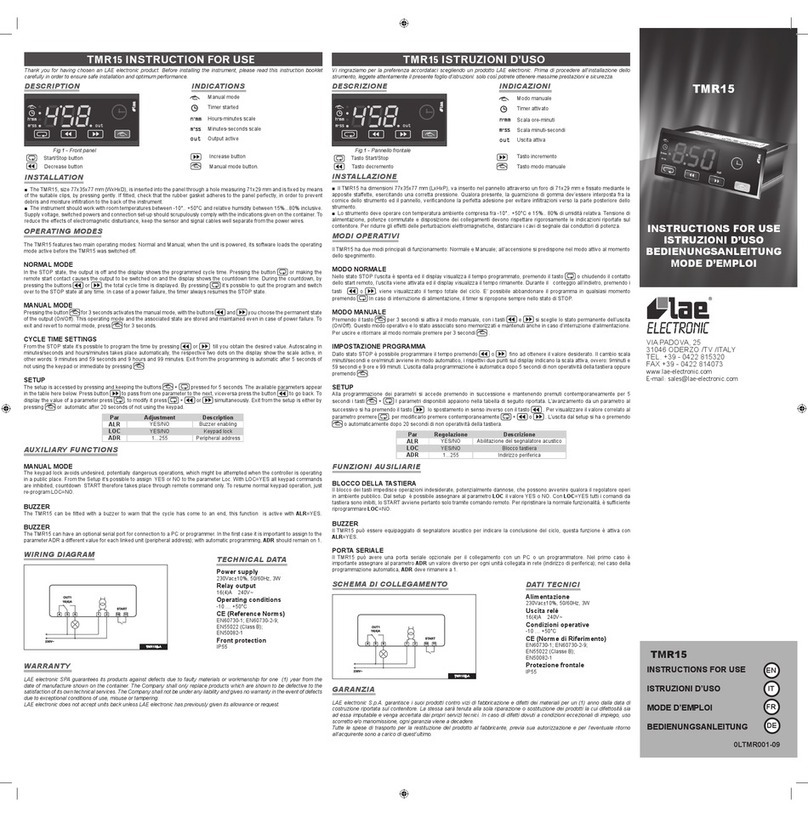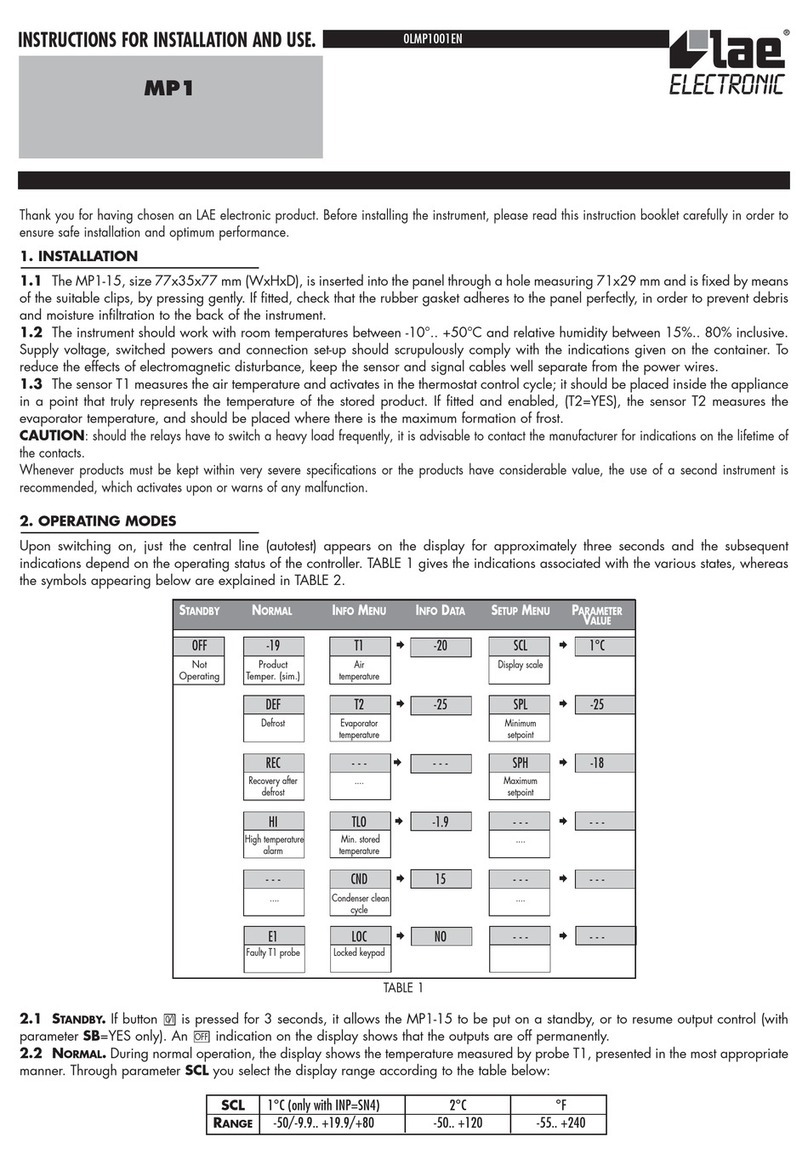LTR-5 BEDIENUNGSANLEITUNG
Wir danken Ihnen, dass Sie sich für ein Produkt der Firma LAE electronic entschieden haben. Lesen Sie vor der Installation
des Gerätes bitte aufmerksam die vorliegende Bedienungsanleitung durch: Nur so können wir Ihnen höchste Leistungen und
Sicherheit garantieren.
BESCHREIBUNG ANGABEN
Wärmeregelungsausgang
Abb. 1 — Bedienteil
Taste Setpoint. Taste Up.
Taste Down. Taste Exit / Stand-by.
INSTALLATION
Das Gerät in eine Bohrung der Abmessungen 71x29 mm einsetzen.
Die Elektroanschlüsse ausführen (siehe hierzu die „Schaltpläne“). Zur Vermeidung von elektromagnetischen Störungen die
Fühler- und Signalkabel getrennt von den Starkstromleitern anbringen.
Das Gerät mit den beiliegenden Halterungen an der Tafel mit leichtem Druck befestigen; falls vorhanden muss die
Gummidichtung zwischen Geräterahmen und Tafel angebracht werden. Auf die korrekte Positionierung achten, um das
geräterückseitige Eindringen von Flüssigkeiten zu vermeiden.
Den Fühler T1 so in der Zelle positionieren, dass die Konservierungstemperatur des Produktes gut gemessen werden kann.
BETRIEB
DISPLAYANZEIGEN
Im Normalbetrieb zeigt das Display die Messtemperatur oder einen der folgenden Werte an:
OFF Regler-Stillstand E1 In tuning: Timeout-Fehler 1
OR Over range oder Bruch T1 E2 In tuning: Timeout-Fehler 2
TUN / 5.4 Autotuning E3 In tuning: Over range-Fehler
SETPOINT (Anzeige und Änderung des Sollwertes - gewünschter Temperaturwert)
Die Taste
mindestens für eine halbe Sekunde drücken, um den Sollwert anzuzeigen.
Die Taste
gedrückt halten und mit den Tasten
oder
den gewünschten Wert einstellen (die Regelung kann innerhalb
des Mindestwertes SPL und Höchstwertes SPH erfolgen).
Beim Loslassen der Taste
wird der neue Wert gespeichert.
STAND-BY
Die Taste , lässt, falls für 3 Sekunden gedrückt, den Regler auf verschiedene Betriebsmodi oder Stand-by umschalten (nur
AUTOTUNING DES REGLERS BEI PID-REGELUNG
Vor dem Start.
Den gewünschten Sollwert 1SP einstellen.
Den Parameter 1Y=PID einstellen
Der Wert des Parameters 1PB muss dem gewünschten Betriebsmodus entsprechen (1PB<0 zum Heizen; 1PB>0 zur
Kühlung).
Start der Funktion.
Die Tasten
+
für 3 Sekunden gedrückt halten. In der Anzeige blinkt 1CT.
Mit der Tasten +
oder
wird die Zykluszeit geändert, um das zeitliche Verhalten des zu steuernden Prozesses zu
bestimmen.
Um die Autotuning-Funktion zu starten, die Tasten + drücken, oder 30 Sekunden warten; um die Autotuning-Funktion
zu verlassen, die Taste
X
drücken.
Bei der Autotuningsphase
Bei der Autotuning-Phase zeigt das Display abwechselnd und den gemessenen Temperaturwert an.
Sollte während dieser Phase der Strom ausfallen, startet beim nächsten Einschalten nach der Selbsttestphase das Gerät
wieder mit der Autotuning-Funktion.
Um die Autotuning-Funktion zu verlassen, ohne dass die vorher programmierten Regelungsparameter modifiziert werden,
muss die Taste
X
für 3 Sekunden gedrückt werden.
Wird das Autotuning erfolgreich beendet, aktualisiert der Regler den Wert der Regelungsparameter und beginnt mit der
Regelung.
Fehler
Wird das Autotuning-Verfahren nicht erfolgreich beendet, blinkt auf dem Display eine Fehlermeldung:
E1 Timeout-Fehler 1: der Regler war nicht imstande, die Systemtemperatur innerhalb des Bereichs des Proportionalbandes
zu bringen. Erhöhen Sie vorübergehend den 1SP-Wert im Fall des Heizbetriebs, vermindern Sie 1SP im Fall des Kühlbetriebs
und starten Sie das Verfahren neu.
E2 Timeout-Fehler 2: das Autotuning-Verfahren wurde nicht innerhalb der maximalen, festgelegten Zeit beendet (1000
Zykluszeiten). Starten Sie das Autotuning-Verfahren neu und stellen Sie eine höhere Zykluszeit 1CT ein.
E3 Over range der Temperatur: kontrollieren Sie, dass der Fehler nicht durch eine Fühleranomalie hervorgerufen wurde;
vermindern Sie vorübergehend den 1SP-Wert im Fall des Heizbetriebs, erhöhen Sie 1SP im Fall des Kühlbetriebs und starten
Sie das Verfahren neu.
Zur Beseitigung der Fehlermeldung und zur Rückkehr zum normalen Betriebsmodus drücken Sie die Taste
X
.
Verbesserung der Regelung
Zur Reduzierung der Überschwingung vermindern Sie den Parameter Reset der Integral-Regelung 1AR.
Zur Erhöhung der Reaktionsfähigkeit des Systems vermindern Sie das Proportionalband 1PB; Achtung: auf diese Weise
verliert das System an Stabilität.
Zur Verminderung der Temperaturschwankungen bei Betrieb erhöhen Sie die Zeit der Integralregelung 1IT; damit wird das
System stabiler, aber weniger reaktionsfähig.
Zur Erhöhung der Reaktionsgeschwindigkeit auf die Temperaturänderungen erhöhen Sie die Zeit der Derivativ-Regelung
1DT; Achtung: ein hoher Wert macht das System empfindlich für geringe Änderungen und kann zu Unstabilität führen.
NEUEICHUNG
Sich ein Präzisionsthermometer oder ein Kalibriergerät besorgen.
Sich vergewissern, dass die Parameter OS1 und SIM 0 betragen
Das Gerät aus und wieder einschalten.
Während der Selbsttestphase die Tasten
X
+
, drücken und gedrückt halten bis der Regler OAD anzeigt.
Mit den Tasten
und
0AD oder SAD auswählen: 0AD ermöglicht die Eichung von 0 und bringt eine konstante Korrektur
auf der gesamten Messskala mit sich. SAd ermöglicht die Eichung des oberen Teils der Messskala mit einer proportionalen
Korrektur zwischen dem Eichpunkt und 0.
Die Taste drücken um den Wert anzuzeigen; dann die Tasten
+
oder
benutzen, um den gelesenen Wert an den
vom Bezugsgerät gemessenen Wert anzugleichen.
Das Verlassen des Eichverfahrens erfolgt durch Drücken der Taste
X
.
KONFIGURATIONSPARAMETER
Für den Zugriff auf das Konfigurationsmenü die Tasten +
X
für 5 Sekunden drücken.
Mit den Tasten
oder
den zu ändernden Parameter wählen.
Mit der Taste
den Wert anzeigen.
Die Taste
gedrückt halten und mit den Tasten
oder
den gewünschten Wert einstellen.
Beim Loslassen der Taste
wird der neue Wert gespeichert und der nächste Parameter angezeigt.
Zum Verlassen des Menüs die Taste
X
drücken oder 30 Sekunden warten.
PAR
MESSBEREICH
BESCHREIBUNG
SCL
1°C;
2°C;
°F
Anzeigeskala.
1°C : Messbereich -5 0 /-19.9 … 99.9 /150°C für LTR-5T
-40/-19.9 … 99.9/125°C für LTR-5C
0.0 … 99.9 % r.F. für LTR-5A
2°C : Messbereich -50 … 150°C für LTR-5T
-40 … 125°C für LTR-5C
00 … 99 %r.F. für LTR-5A
°F : Messbereich -60 … 300°F für LTR-5T
-40 … 250°F für LTR-5C
Achtung: Bei der Änderung des Wer tes SCL müssen die Parameter der absoluten und relativen Temperaturen (SPL,
SPH, 1SP, 1HY, usw.) unbedingt neu konfiguriert werden.
SPL
-50..SPH Mindestgrenzwer t für die Regelung von 1SP.
SPH
SPL .150° Höchstgrenzwert für die Regelung 1SP.
1SP
SPL ... SPH Schalttemperatur (Wert, der in der Zelle beibehalten werden soll).
1Y
HY / PID Regelungsmodus.
Mit 1Y=HY erfolgt die Regelung mit Schalthysterese: in der Regelung werden die Parameter 1HY und 1CT benutzt.
Mit 1Y=PID erfolgt eine Propor tional-Integral-Derivativ-Regelung: in der Regelung werden die Parameter 1PB, 1IT,
1DT, 1AR, 1CT benutzt.
1HY
-19.9…19.9°C Schalthysterese [Regelung mit Schalthysterese].
Den Parameter 1HY auf einen Wert grösser als Null einstellen (z.B.: +2k), um den Ausgang im Kühlmodus steuern zu
können oder auf einen Wert kleiner als Null eins tellen (z.B.: -2k) , um den Ausgang im Heizmodus steuern zu können.
Mit 1HY= 0 bleibt der Ausgang immer ausgeschaltet.
OFF
ON
1SP 1SP+1HY
T[°]
OFF
ON
1SP1SP-1HY
T[°]
Bild 1a. ON/OFF-Regelung im Kühlmodus (1Y=HY,1HY>0). Bild 1b. ON/OFF-Regelung im Heizmodus (
1Y
=HY,
1HY
<0).
1PB
-19.9…19.9°C Proportionalband [PID-Regelung] .
Den Pa ramete r 1PB auf ein en Wert gr össer al s Null ein stell en,
um den Ausgang im Kühlmodus steuern zu können, oder auf
einen Wert kleiner als Null einstellen, um den Ausgang im
Heizmodus steuern zu können. Mit 1PB= 0 bleibt der Ausgang
immer ausgeschaltet.
Ineiner Proportionalregelung,erfolgt die Temperaturregelung
durch die Änderung der Aktivierungszeit des Ausganges: je
näher die Temperatur am Sollwert liegt, desto geringer ist
die Aktivierungszeit. Ein kleines Proportionalband erhöht die
Reaktion des Systems auf Temperaturveränderungen, macht
es aber weniger stabil. Eine rein proportionale Regelung
st abilis iert d ie Temperat ur inne rhalb des P ropor tio nalbande s,
annulliert aber nicht die Abweichung vom Sollwert.
1IT
0…999s Zeit der Integralregelung [PID-Regelung].
Durch Aktivierung des Integral-Anteils, bei
einer Proportionalregelung, wird eine bleibende
Sollwertabweichung verhindert.
Die Zeit der Integralregelung bestimmt
die Geschwindigkeit der Temperaturfehlerannullierung;
eine hohe Geschwindigkeit (niedrige 1IT) kann
aber zu Überschwingung und Unstabilität der
Regelung führen. Mit 1IT= 0 wird die Integralregelung
deaktiviert.
1DT
0…999s Zeit der Derivativ-Regelung [PID-Regelung].
Durch Aktivierung des Derivativ – Anteils, bei
einer Proportional-Integral Regelung wird ein
zu starkes Überschwingen verhindert.
Ein Regler mit starker Derivativ-Regelung ( hohe 1DT) ist sehr
empfindlich für geringe Temperaturänderungen und kann das
System unstabil machen.
Mit 1DT= 0 wird die Derivativ-Regelung deaktiviert.
1AR
0…100% Reset der Integralzeit bezüglich 1PB [PID-Regelung].
Durch die Verkleinerung des Parameters 1AR verkleinert sich auch die Wirkungszone der Integral-Regelung, und
die Überschwingung infolgedessen ( siehe Bild beim Abschnit t 1IT).
1CT
…255s Zykluszeit.
Im ON/OFF-Modus (1Y= HY), nach einer Umschaltung, bleibt der Ausgang in seinem neuen Zustand für eine
Mindestzeit von 1CT Sekunden, unabhängig vom Temperaturwert.
Im PID-Modus (1Y= PID) ist die Zykluszeit die Zeit , in der der Ausgang einen Zyklus (Zeit ON + Zeit OFF) ergänzt. :
je höher die Reaktionsgeschwindigkeit des Systems ist, desto geringer muss die Zykluszeit sein, um eine größere
Stabilität der Temperatur und eine geringere Empfindlichkeit gegenüber Lastschwankungen zu erhalten.
1PF
ON / OFF Ausgangszustand bei einem Fühler fehler.
BAU
NON / SBY Mit BAU =SBYwirddieStand-by-Tasteaktiviert.
SIM
0...100 Displayverlangsamung.
OS1
-12.5..12.5°C Messwertkorrektur des Fühlers T1.
ADR
1...255 Adresse von LTR-5 für Kommunikation mit einem PC.
SCHALTPLÄNE
TECHNISCHE DATEN
Spannungsversorgung
LTR-5…D 12Vac /dc±10% , 2W
LTR-5…E 23 0Vac±10 %, 50 /60Hz, 2W
LTR-5…U 115Vac±10%, 50/60Hz, 2W
Relaisausgang (LTR-5..R..)
LTR-5.SR.. OUT1 16(4) A
LTR-5.QR.. OUT1 12(4)A
SSR-Steuerung (LTR-5.1F..)
OUT1 15mA 12Vdc
Eingänge
LTR-5A…: 0-1V
LTR-5C…: NTC 10K Ω@25°C, codice L AE SN4...
LTR-5T…: PTC 10 00Ω@25°C, codice LAE ST1…
Messbereich
LTR-5A…: 0…9 9%r.F.
LTR-5C…: -4 0…125°C
LTR-5T…: -50…150°C
Messgenauigkeit
LTR-5A…: <±0.7%r.F. im Messbereich
LTR-5C…: <± 0.3°C -40…100°C; ±1°C anderswo
LTR-5T…: <±0.3°C -50…140°C; ±1°C anderswo
Betriebsbedingungen
-10 … +50°C ; 15…8 0% rF
CE (Bezugsnormen)
EN60730-1; EN60730-2-9;
EN5 5022 (Klasse B);
EN50082-1
Frontschutzart
IP55
PARTNER VENEZIA • 041 5460713
LTR-5
INSTRUCTIONS FOR USE
BEDIENUNGSANLEITUNG
EN
DE
VIA PADOVA, 25
31046 ODERZO /TV /ITALY
TEL. +39 - 0422 815320
FAX +39 - 0422 814073
www.lae-electronic.com
LTR- 5
INSTRUCTIONS FOR USE
BEDIENUNGSANLEITUNG
6 7
OUT1
12(4)A
234
910 11
rH
V
VINV+ V-
TTL
230V~
data I/O
LTR-5AQRE-A
RS485
2346 7
OUT1
16(4)A
10 11
230V~
data I/O
LTR-5TSRE-B
RS485
6 7
OUT1
S.S.R.
+-
15mA
4
12V
3
10 11
230V ~
data I/O
LTR-5CSFE-B
1SP
1PB
Temperatur
Überschwingung Fehler bei Betrieb
Temperatur
des Verfahrens
Zeit
1SP
1PB
Temperatur
Überschwingung
Wirkungszone
der Integralregelung
Temperatur
des Verfahrens
Zeit
1PBx1AR%
1SP
1PB
Temperatur
Überschwingung
Temperatur
des Verfahrens
Zeit
ISTR LTR-5 INGL/TED.indd 2ISTR LTR-5 INGL/TED.indd 2 11-12-2007 15:45:3311-12-2007 15:45:33
1
0LLTR002-01
bei BAU=SBY).





















